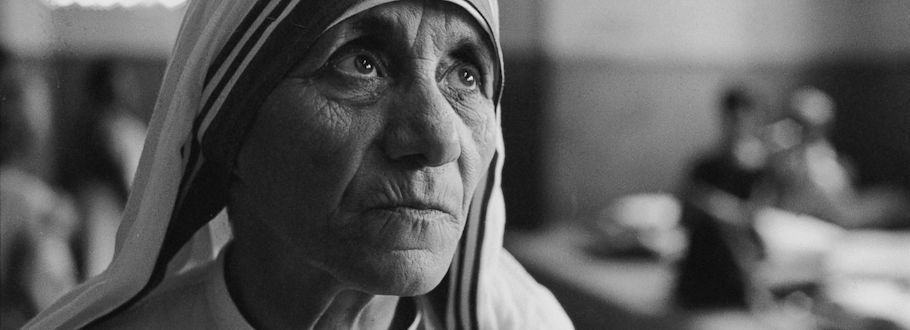Yesterday we heard the unsurprising news that Pope Francis has approved Mother Teresa for sainthood. She will be officially declared a saint this September, 19 years after her death. For Protestants like myself, this raises a couple of important questions: According to the Roman Catholic Church, what is a saint? And how can a person become one anyway?
According to Catholic doctrine, dead saints benefit the living faithful by being available to them for intercession.
The Roman Catholic Church has a formal process they must follow before declaring a person a saint. This process is not meant to make a saint, but to recognize one. According to the Roman Catholic Church, a saint is a person of extraordinary, heroic Christian virtue, someone who exemplified holy living. Such holy living gives confidence that this person is not currently in hell or purgatory but in heaven, enjoying full communion with God. Because of this communion with God, Christians can now pray to that person and ask his or her intercession with the Father. This helps explain why Roman Catholics place such emphasis on sainthood—According to Catholic doctrine, dead saints benefit the living faithful by being available to them for intercession.
So how, then, does the church declare a person a saint? In most circumstances, there must first be a 5-year waiting period between the person’s death and the commencement of the canonization process. (To “canonize” is to officially declare a person a saint.) However, under some circumstances this requirement is waived, as it was with both John Paul II and Mother Teresa. Once begun, the process involves a number of steps, each of which involves bestowing a title upon the candidate for sainthood.
- Servant of God. After the 5-year waiting period (or the waiver) individuals or organizations within the diocese where the person died or is buried can lobby the local bishop to begin an investigation into that person’s life and virtue. They need to prove that the candidate lived an exemplary life and held faithfully to doctrine consistent with the teachings of the Roman Catholic Church. If sufficient evidence is gathered and produced, the bishop may then ask the Vatican’s Congregation for the Causes of the Saints to consider the case. If and when the Congregation accepts the case, the candidate under consideration is granted the honorific title “Servant of God.”
- Venerable. The Congregation for the Causes of Saints looks at all of the evidence given to them, pursues new lines of evidence, and determines if this person lived a life of “heroic virtue.” If it is found that the person did, indeed, display exemplary holiness, the candidate is officially declared “Venerable.” It is important to note that this does not yet establish that the person is in heaven, but simply that he or she lived a life of exceptional holiness. However, at this point the faithful are encouraged to begin praying to the candidate for miraculous intercession.
- Blessed. The third step is beatification and for this to happen, the person must be credited with a verified posthumous miracle. This miracle must be the result of the candidate’s intercession in response to petitions offered after his or her death. These miracles are almost always medical, healings that must be instantaneous, complete, permanent, without scientific explanation, and not attributable to any other saint. The miracle is taken as proof that the person is in heaven, able to intercede between God and man. Upon verification of the miracle, the candidate is given the title “Blessed” and the pope establishes a feast day in his or her honor. This person may now be venerated and churches named after him or her, but only locally within a region, diocese, or religious order. (“Veneration” is a difficult term to define but is usually described as a lower form of worship than the worship given to God and Mary. It involves praying to or petitioning that person for their prayers and often creating statues or images of him or her as an aid to such acts.)
- Saint. The final step is canonization where the person is formally declared a saint. For this to occur, the person must be credited with a second miracle. When this second miracle has been verified, the pope assigns a feast day that may be celebrated by any Roman Catholic in any place. Any person may now pray to that saint and churches or organizations around the world may be named after him or her. The person’s sainthood is formally declared during a special papal mass said in his or her honor.
In the case of Mother Teresa, she has long been considered an exemplar of Catholic virtue, and her life and writings have been declared free from heresy. She has been formally recognized by the Vatican as responsible for two posthumous miracles: the healing of an Indian woman’s abdominal tumors after a locket containing her picture was laid on the patient’s stomach and the healing of a Brazilian man’s brain infection and abscesses. All that now remains is for the pope to declare her Saint Teresa of Calcutta, a task he will complete in September.
We are saints who have no need of saints.
How do we, as Protestants, think well about all of this? So much could be said and the more we say the deeper we would need to dig into the intricacies and errors of Roman Catholic doctrine and practice, especially as it relates to justification, sanctification, and glorification. But perhaps we can at least say this: We are saints who have no need of saints. All who have believed in the gospel of grace alone through faith alone in Christ alone have already been declared saints by God (see Romans 1:1-7, 1 Corinthians 1:1-3, 2 Corinthians 1:1-2, and Ephesians 2:19-21). We are God’s holy people, called by him and to him. Jesus Christ is the full and final mediator between God and men (1 Timothy 2:5) who invites us to confidently approach the throne of grace (Hebrews 4:16) believing that his Spirit is already interceding on our behalf (Romans 8:26-27). We are the saints of God who have no need for the intercession of saints who have gone before.










